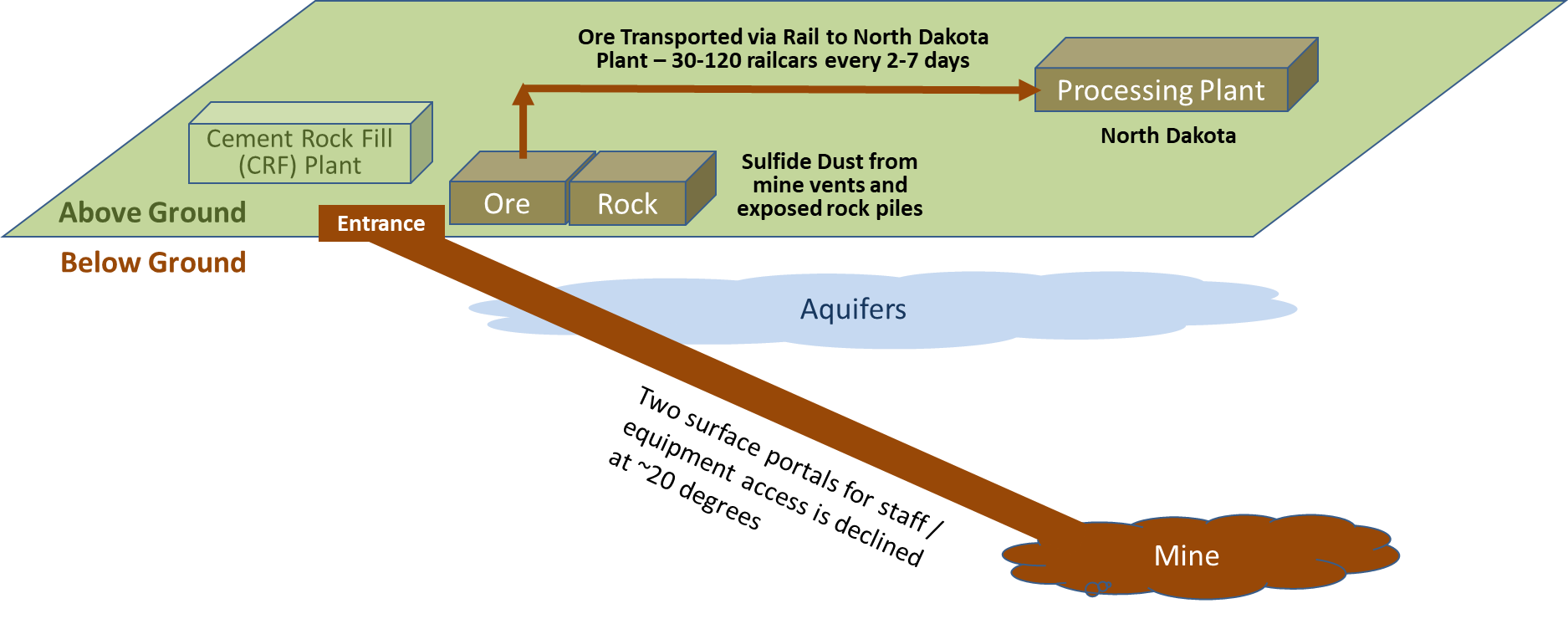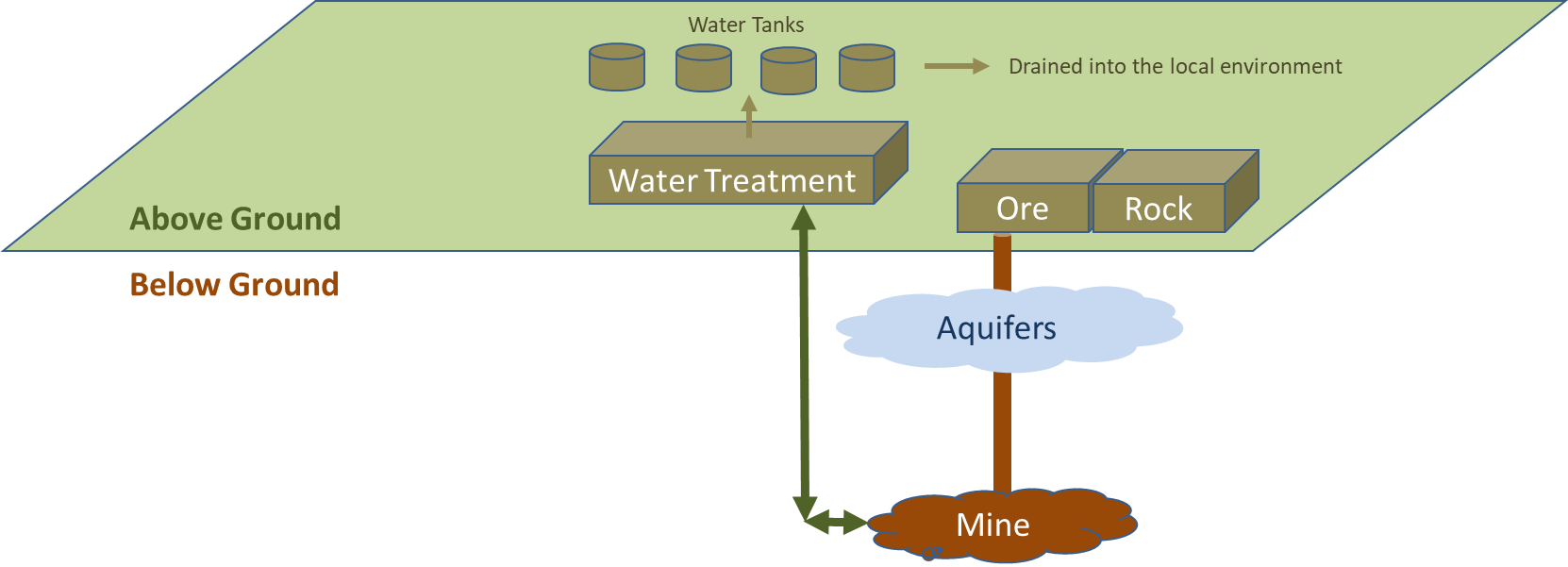The Tamarack Mine
Mine Overview
The proposed Talon Metals mine in Tamarack is an underground mine. Ore extracted from the mine is planned to be shipped to a new processing plant in North Dakota (announced by Talon in October 2022).
The mine will have two surface portals to provide primary access for personnel, materials and exhaust ventilation. These ramps will decline at a slope of approximately 20 degrees. These shafts will also serve as the main fresh air intake for the mine and the main conduit for mine services. The shafts will be approximately 1700 feet deep with a 12" concrete liner at a 20 degree angle which is very steep. Since this is a very wet mine, this ramp will be very slipperly and dangerous as machinery is driven in and out of the mine.
Once down to the level of the deposit, lateral tunnels are created around and into the mineral deposits to extract the ore.
Stopes (large underground rooms) are created through blasting (mulitple times a day) and the ore is then brought to the surface for storage and shipping. It is expected that the mine will extract
approximately 3,600 metric tonnes of material per day. This is about 4000 US tons per day. At approximately 85 tons per rail car, this equates to about 47 rail cars per day.

Dust and Blasting Concerns
Underground blasting is likely used to release ore from bedrock. We note that at the Eagle Mine in Michigan, people can feel the blasts at all hours often twice a day from MANY miles away. Dust created by the blasting underground is vented to the surface where it is must be filtered for fine toxic materials (which Talon does not plan to do). Mine operations generate significant air borne pollution vented directly into the atmosphere and as such, Talon needs to filter the main exhaust shafts with industrial air filters capable of removing potentially toxic dust from blasting. Talon will also need to implement dust mitigation for normal material handling (loading and transfer of ore and rock) as well as covering the storage areas and rail cars to prevent wind blown propagation of toxic dust. We note however that rail cars must have seep holes at the bottom to drain water that may collect in the car. Thses seep holes will also leak toxic materials all along the railways from Tamarack to North Dakota.
In addition, the ore loaded into the train cars will likely be very wet given the amount of mine water that must be pumped out. In cold weather, this ore will freeze in the rail car by the time it gets to North Dakota making it impossible to remove for processing. How will Talon deal with this in an environmentally safe way?
Originally, an on site processing plant was planned to process the extracted ore. This plant would have produced a significant quantity of high sulfide tailings. The original plan was to backfill the fully mined stopes (the large underground caverns left by removing the ore) using a cement based paste backfill mixed with high sulfide tailings and development waste rock. If the mined out stopes can no longer be filled (there are no tailings to create the paste backfill) there could be a large increase of water flowing from the acquifers into the mine from exposed water features and thus creating a significant amount of additional water that must be pumped out. They could use development rock and imported sand and gravel, mixed with cement, to fill these areas. However, the developmnet rock will need to be crushed potentially creating more toxic high sulfide dust.
Water Concerns
There are two main sources of water that must be removed from the mine, service water needed for underground operations and mine water entering from all of the aquifers above via what Talon calls "water bearing features" in the exposed rock.

Relative to mine service water, the Eagle Mine report and tour information, the 2020 Talon PEA and the 2021 PEA all talk about how much water is needed for underground operations. You need to pump water down into the mine for:
- Diamond drill lubrication for pilot hole drilling and flushing of waste
- Pressure washers to clean the underground equipment
- Dust suppression for the underground crusher and conveyor loading area
- Pressure washers for general dust mitigation
- Shotcrete machine cleaning and sump flushing
- Backfill Line flushing
- Removal of loose rock after blasting
- Muck pile wash down
- And other purposes
Generally, when Talon adds up all of the above water needs, they estimate about 330,000 gallons of water per day for underground mine operations (see page 227 of the Talon 2021 PEA - link in the footer of this page). This is based on the known water needs for each piece of equipment and use. And of course, this is all consistent with what the Eagle mine reports. And these pumping requirements are fairly consistent between the 2020 to the 2021 PEA. This water does not soak into rock, it needs to be pumped out, thus dewatering of the mine is required and becomes a part of the total mine pumping requirements.
In addition, both the 2020 and 2021 PEA conclude that there will 9.9 gallons / minute per water bearing feature coming in from the aquifer with an average of one water bearing feature per 216 meters of drill data as measured through past data logging. This is a scientifically supportable level of water inflow based on Talon facts and of course, this inflow increases as the mine surface area increases. This is well documented on page 228 of the 2021 PEA. Here Talon estimates between 2.3-2.6 million gallons of water per day must be pumped out of the mine based on an average inflow noted above. However, if the stopes are no longer filled with the paste backfill that is waterproof, one could expect the number of water bearing features to increase dramatically. In addition, daily blasts are likely to open new fissures in the bedrock increasing the water flow. This raises the question, How much beyond the 2.3 million gallons a day must now be pumped? Will it be 5 million gallons? More?.
Inevitably, Talon must ship in gravel and sand to be used for filling the stopes as the development rock is used up. Talon plans to extract 3600 tonnes (metric) of material per day (per their PEA). That's about 4000 US tons. To replace that material, logically, you would need to fill with approximately 4000 tons per day of gravel (mixed with a bit of cement for the paste fill). Now it is true that sand and gravel can take up more area per tonne of weight due to the air gaps between the grains of sand and gravel. But loosely backed sand and gravel cannot be used since water will leak through these air gaps greatly increasing pumping requirements. The sand and gravel, mixed wth cement must be highly compacted to be "waterproof" so that indeed, close to 4000 tons per day will be needed (despite what Talon claims). That's another 40-50 large train cars of sand and gravel per day that most be shipped into the facility from someplace, everyday, 365 days a year for 18-12 years. It is not clear where they might get this material.
The 2.3+ million gallons of water is dirty water (contaminated by sulfide dust as well as direct contact with the sulfide ore). Treatment of this water would require large, energy intensive industrial filters that change the water chemistry impacting local lakes, wetlands and aquifers when the water is released into the environment. In addition, how does Talon know how to engineer the size of this treatment plant when they appear to have no idea how much added water will result from blasting and leakage from filled stopes? Will they just dump contaminated water that they can't filter? And where does Talon release this water? Will a new lake be created? Can the aquifers be replenished? How much will lake and wetland water levels drop? All unanswered questions.
The Michigan Eagle Mine is an underground nickel-copper mine similar to what is being proposed for Tamarack (See www.eaglemine.com/_files/ugd/c6167e_568f076601bc48e7a02b54f222b4165a.pdf for details related Eagle Mining monitoring anomalies). At one of the Eagle Mine monitoring points, the mean water level readings in 2022 indicated a maximum of 2.8 feet (ft) below the calculated minimum background baseline level. The mine attributed this drop in water levels pumping of the mine services well and groundwater infiltration into the mine. This drop in water levels is due to an average pumping requirement of 80,000 to 150,000 gallons a day – but the Talon Tamarack site must pump 2,300,000+ gallons per day! How much will surface water levels drop?
In addition, the Eagle mine listed at least 20 monitoring events that show levels of pollution and water chemistry changes outside the planned benchmark range – some with sulfate levels that exceed Minnesota's wild rice standards by a factor of 1500.
Rock and Ore Storage Concerns
There will likely be multiple storage facilities on site at the mine. Development rock excavated from the tunnels that descend into the mine and connect the various mineral deposits will generally be stored on the surface. This rock can be used later to fill mined out stopes to some extent but must be crushed (causing more toxic dust) since this rock may be contaminated with sulfide and other toxic minerals. The Eagle Mine report (referenced above) lists 33 toxic substances being monitored. In addition, ore must be stored prior to transport to North Dakota. These storage areas must be lined to prevent contamination from seeping into the ground water. We note that Eagle Mine TDRSA (Temporary Development Rock Storage Area) is lined with both a primary and secondary lining. A leak detection system is installed between the liners to monitor primary lining integrity. A total of approximately 55 gallons of water was purged from the leak detection sump in 2020, a larger volume than 2019. Thus we see that the lining system does leak after only a few years of operation. The leak levels are currently very small at this point but as noted in the 2020 Eagle Mine report, increasing slightly over time.